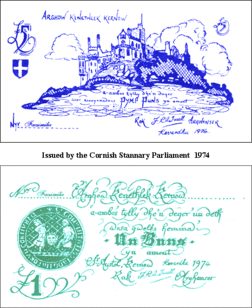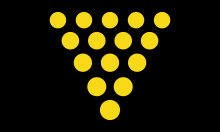- Cornish currency
-

Numismatics Terminology
 Portal
PortalCurrency Circulating currencies
Community currenciesAncient currencies -
Greek, Roman
ByzantineModern currencies
-
Africa, The Americas,
Europe, Asia, Oceania
Production -
Mint, Designers
Exonumia Cornish currency 
£5 and £1 issued by the Cornish stannary parliament 1974 User(s) Cornwall see also Constitutional Status of Cornwall Subunit 1/100 dynar, pound sterling Symbol d, £, /~ Banknotes 500d, £1, 5/~, 10/~, 50p Cornish currency has been issued in various forms since medieval times and possibly earlier. One early story tells that the Cornish people raised the money by popular subscription to pay a ransom for the release of the Duke of Cornwall, Richard the Lionheart. The 15 Bezants on the arms of the Duke of Cornwall are said to represent the money raised. In heraldry, bezants are gold discs (roundels). Their name as a charge probably comes from the name of the coins.
Another early reference to the Cornish currency, the "dynar", is found in a thirteenth century Cornish play in the line "dhodh a dela pymp cans dyner", which translates as "he was owed five hundred dyner". The only English coin at the time was the silver penny: presumably the dynar was equivalent to this.
Contents
Cornish mints
The earliest known Cornish mint was at Launceston (originally at St Stephen by Launceston), which operated on a minimal scale (before Cornwall received full diocesan jurisdiction in the year 994 AD) at the time of Ethelred II, 976. Only one specimen is known to exist. The one available early coin is heavy (1.61g).[1][2] However after the Norman Conquest the Norman Earl acquired Dunheved and rebuilt the castle there. He expropriated the market and mint of the canons and the townspeople followed them to Dunheved.[3] The mint was reopened half-way through the Conqueror's reign.[citation needed]
A Royalist mint was established in Truro in 1642-43 during the English Civil War by Sir Richard Vyvyan; in September 1643 it was moved to Exeter.[4][5]
Cornish Banks
Several Cornish towns in the mining districts set up their own Banks and even issued their own banknotes. One example is 'The Mounts Bay Commercial Bank' which was set up 1807 by the Bolitho family of Penzance. The Consolidated Bank of Cornwall was taken over by Barclays Bank in 1905.[6] In 2004 a rare banknote from the Falmouth bank sold for £540.[7] Several other examples of Cornish banknotes are held at the County Museum in Truro.
Stannary money
In more recent times Cornish currency was issued by the Cornish Stannary Parliament in 1974 under the name of the ‘Cornish National Fund’. The Cornish National Fund was established with the objective of raising funds to assist with a "campaign for the restitution of Cornwall’s legal right to partially govern itself and to raise appreciation within Cornwall of the aims of the Stannary Parliament."[8]
The 1974 banknotes were issued in denominations of 5 shillings, 10 shillings, 1 pound and 5 pounds. Cornish language text on the front of the 5 shilling note can be translated as: 'The National Fund of Cornwall promises to pay the bearer one day after sight the amount of five shillings.' In 1985 the Cornish Stannary Parliament issued notes of two denominations –- 50 pence and 1 pound—and were sold at a premium as a matching pair as a fund raising exercise. In 2000 the Cornish Stannary Parliament issued new banknotes in the denomination of 500 Dynars to commemorate the 200-year anniversary of Richard Trevithick's steam car climbing Camborne Hill on Christmas Eve 1801. On the front of the note there is a depiction of Saint Piran (Peran Sans), carrying his banner and standing before a stone cross.[9]
On 15 December 1974, it was announced that Frederick Trull, styled "clerk to the stannary", was to issue banknotes in four denominations. Following an incident on 26 February 1975 when Trull attempted to arrest the clerk and magistrate while being tried for a motoring offence at St Austell Magistrate's Court, he was found guilty of using threatening words and behaviour with intent to provoke a breach of the peace on 2 June 1975. He produced twenty-five pages of documents in an attempt to prove that the court had no jurisdiction but was fined, ordered to pay costs, and bound over to keep the peace for twelve months. He was subsequently dismissed from his post as clerk to the stannary and expelled from the organisation. The banknotes, which bore Trull's signature, were burnt.
Cornish tokens
Cornish tokens sometimes called Cornish Pennies were trade tokens widely used in the 18th and 19th century in Cornwall.
- One dated 1811 had the words, "For the accommodation of the county," in the centre was a pilchard between cakes of copper and ingots of tin. On the other side were the words Cornish penny, in the centre a view of a mine pumping engine and winding gear.
- The 1791 Cornwall Conder Token, (halfpenny) had "Cornish Copper Half an Ounce" written around a Duchy bezant shield and a druid's head on the reverse.[10]
- Cornish pennies issued by John Williams of Scorrier are also found: one dated 1812 has on the obverse the badge of the Prince of Wales (three plumes) and on the reverse a view of a mine pumping engine and winding gear and "Payable at Scorrier House / One pound for 240 tokens".
Local Exchange Trading Schemes (LETS) in Cornwall
The LETS scheme which runs across the UK. Of the schemes that run in Cornwall, each has its own local currency that is thought of as equivalent to £1 but this can be flexible.[11] For example
- PECs (Penwith Exchange Currency) in Penzance .
- LANS in Launceston
- CELTS in Falmouth
- CARTS (Camborne & Redruth Trading Scheme) in Camborne and Redruth
See also
- William John Hocking of the Royal Mint
References
- ^ Metcalf, David Michael (1998) An Atlas of Anglo-Saxon and Norman Coin Finds, c. 973-1086. Oxford: Ashmolean Museum
- ^ British Numismatic Journal; ser. I, vol. 3, p. 107, pl. 264
- ^ Cornish Church Guide (1925) Truro: Blackford; p. 198
- ^ "The 'five bob' that turned into £1,400". Thisiscornwall. 2010-03-29. http://www.thisiscornwall.co.uk/news/bob-turned-163-1-400/article-1952390-detail/article.html. Retrieved 4 September 2010.
- ^ "Mintmarks Charles I & Charles II". http://www.psdetecting.com/Mintmarks-CharlesI-&-CharlesII.html. Retrieved 4 September 2010.
- ^ http://www.cornish-mining.org.uk/story/tin.htm
- ^ [news.bbc.co.uk/.../newsid_8625000/8625288.stm 200 year old Falmouth bank note sold in London auction]
- ^ The Cornish Stannary Parliament by Peter Symes
- ^ Cornish Dynar banknotes
- ^ 1791 Cornwall Conder Token
- ^ Falmouth Local Exchange Trading Scheme
- Williams, J. A. (1971) Cornish Tokens. Truro: D. Bradford Barton ISBN 0851530184
External links
- Cornish national fund currency 1974 & 1985
- Private Issues – The Cornish Stannary Parliament
- Famous People of Polperro - Zephania Job
- Information about German sub-currencies
- Cornish coins and currency - article by George Care
- Kates Paper Money
Geography of Cornwall Cornwall Portal Unitary authorities Major settlements Bodmin • Bude • Callington • Camborne • Camelford • Falmouth • Fowey • Hayle • Helston • Launceston • Liskeard • Looe • Lostwithiel • Marazion • Newlyn • Newquay • Padstow • Par • Penryn • Penzance • Porthleven • Redruth • Saltash • St Austell • St Blazey • St Columb Major • St Ives • St Just-in-Penwith • St Mawes • Stratton • Torpoint • Truro • Wadebridge
See also: Civil parishes in CornwallRivers Topics History • Status debate • Flag • Culture • Places • People • The Duchy • Diocese • Politics • Hundreds/shires • Places of interest • full list...Categories:- Cornish nationalism
- Community currencies
- Economy of Cornwall
Wikimedia Foundation. 2010.

